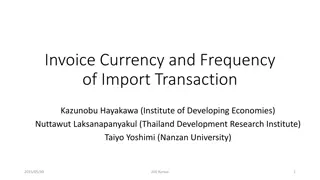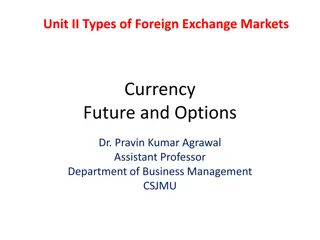Currency Risk Management Strategies for Impact Investment Funds in Frontier Markets
Small Foundation (SF) commissioned ISF Advisors to analyze foreign currency risk management strategies for impact investment funds in African early-stage MSMEs. The report highlights the challenges faced and provides recommendations for effective currency risk management strategies to achieve commercial viability while minimizing FX losses.
Download Presentation

Please find below an Image/Link to download the presentation.
The content on the website is provided AS IS for your information and personal use only. It may not be sold, licensed, or shared on other websites without obtaining consent from the author.If you encounter any issues during the download, it is possible that the publisher has removed the file from their server.
You are allowed to download the files provided on this website for personal or commercial use, subject to the condition that they are used lawfully. All files are the property of their respective owners.
The content on the website is provided AS IS for your information and personal use only. It may not be sold, licensed, or shared on other websites without obtaining consent from the author.
E N D
Presentation Transcript
July 2022 Foreign Currency Risk Management Strategies for Impact Investment Funds in Frontier Markets
Purpose and Background of Research Small Foundation (SF) seeks scalable and sustainable models that support the micro- small and medium enterprise (MSME) ecosystem in Africa. Currency risk management is a key challenge to achieving commercial viability for funds investing in African early-stage MSMEs. We commissioned ISF Advisors to analyse available strategies for hard-currency funds in frontier and emerging markets to manage foreign currency risks. This report presents an overview of common strategies and tools for local currency risk management. We do not believe that this is an easy problem to solve and we are primarily looking for solutions that have a pathway to commercial viability: Grants are eliminated or at least minimized when it comes to FX losses Any mechanism is designed with a pathway to commerciality in mind Any mechanism is simple and cost efficient to implement
Executive Summary Local Currency ( LCY ) Investments o LCY investments are appropriate for many local SMEs but this gives rise to currency risk for investment vehicles that must be managed. o Understanding each country s monetary, economic and currency market dynamics is critical to making appropriate risk / return assessments to create a balanced and well-managed portfolio. Hedging o Currency hedging involves investing in financial products with credible counterparties to increase the predictability of currency outcomes where risks exist but is not a panacea for LCY investing. o Efficient hedge pricing and structuring depends on pricing, liquidity, currency availability and local market policies. o Frontier markets tend to be inefficient, which limits the availability of appropriate products, tenors and accurate pricing. The risks of capital controls, parallel currency markets and government market interventions are also present. Funder Recommendations o Collaborate with fund design stakeholders, including anchor investors, advisors and potential fund managers, to create an appropriate currency management strategy: LCY market knowledge, maximum LCY allocations, credit line / collateral provisions and subsidy / grant inclusion. o Include currency risk management as a core requirement and competency for investment managers: currency risk management experience and track record, policies and procedures. o Consider subsidized currency risk management at the fund level, particularly to offset risks of local government intervention.
Funds consider currency management strategies from the outset in order to set risk and return expectations with investors Fund Design Fund managers elaborate currency management strategies alongside principal investors sponsors during the design phase of the fund considering new investor expectations and the balance of what s achievable at the investment level. Investor & Market Considerations Investor appetite, fund manager capabilities & market availability No Management Passive Management Active Management o Pass the currency exposure risk to the fund investors o Permits the fund investors to manage the currency risk for themselves o Funds used entirely for investments in targeted assets o Fund manager focuses only on targeted investments o Funds are not used for currency management investments o Adapt investment to protect against currency movements (e.g., obligate investees to hedge) o Currency risk fully integrated into portfolio construction and diversification o Funds are used to enter into currency management obligations (e.g., hedge contracts) o Balance downside protection with upside sacrifice and potential liability exposure o Utilize local market and financial product skill set to make prudent decisions In all cases the fund manager must price the currency risk into targeted returns. Active management can incorporate all three general strategies to balance currency risk downside protection and upside capture.
Broad strategic LCY exposure decisions lead to structural and management implications for the fund, and drive use of products that best suit a fund Management Product alternatives Structure Broad strategy Gating decision Financial instruments No Separate currency management entity ring fences FX risk Within the fund entity? 3rd party FX manager Yes Yes FX services Actively manage FX exposure? Yes Fund entity bears FX risk GP manages FX exposure No Passively manage FX exposure within the fund entity? Subsidies No Portfolio company bears FX risk Investee manages FX exposure No LPs manage FX exposure themselves Development grants Yes LP manages FX exposure LPs bear FX risk
Impact funds struggle to meet SME demand for LCY funding Hard Currency ( HCY ) Investment Local Currency ( LCY ) Investment o Increase impact by extending funding to SMEs with LCY revenues (e.g. local sales) o Enhance liquidity in frontier markets through increase in direct foreign investment o Exposure to potential positive appreciation of LCY o Eliminate / reduce investor exposure FX risk o Eliminate / reduce a fund s exposure to FX risk o Simplify a fund s investment management Why? o Fund high-growth SMEs that operate in local markets with LCY revenues o Bring capital on-shore to invest in locally registered entities o Fund manager implements currency management strategy in line with policies o Fund exporters with access to international markets and HCY revenues o Invest in offshore vehicles o Obligate investee to bear currency mismatch and funds flow risks How? o Exposure to currency risks (e.g. devaluation, monetary and capital controls) o Currency market inefficiency may lead to lack of product availability, overpricing and settlement risk o Likely precludes SMEs with LCY revenues from receiving funding Disadvantages Funds typically invest a small portion of assets in LCY, and only hedge a portion of this. LCY portfolio balance considerations include (i) expected LCY returns, (ii) expected currency performance vs. hedging costs + associated risks, and (iii) country-specific costs.
Funds must consider whether an investees LCY return has the capacity to meet the fund s own financial return objectives Unhedged Return Hedged Return = Gross LCY Return Local Taxes Currency Depreciation Transaction Costs Other Local Market Risks = Gross LCY Return Local Taxes Hedge Costs Hedge Risks Transaction Costs Other Local Market Risks Calculation: Does the USD return meet Fund requirements? Currency Performance/ Pricing Indicators: Is the hedge affordable? o Inflation differentials o Interest rate differentials o Forward curve o Implied volatility of spot rate o Proprietary broker models o Counterparty availability o Low spot market liquidity means less data points for predicting future performance o Political, market and economic instability can cause unpredictable currency shocks Result: Lack of currency performance certainty o Low reference and secondary market liquidity negatively impacts pricing accuracy o Local market controls mean most products are non-deliverable, settled off-shore Result: Pricing inaccuracies and high settlement risk Frontier Market LCY Risks: Is the hedge worth it ? Note: Hedges only partially address LCY investment risks. If LCY returns => Fund s USD return & local market thresholds, then consider LCY investment. If expected LCY depreciation or volatility > hedging costs, then consider hedge.
LCY investments incur transaction and country-specific costs related to bringing foreign capital on-shore that are not covered by currency hedges o Occurs in the time between capital disbursement in USD and receipt of funds in LCY. o Depends on banking infrastructure, currency availability and daily rate movements. o Fund transfers may take several days, during which exchange rates may change, resulting in investment capital oversupply or shortfall. o Normally covered by short-dated forwards, which may be relatively costly and difficult to come by for certain currencies, or overfunding. Slippage (~0.1-0.3% per distribution) o Currency fees will be charged by the converting bank upon initial investment and for remittances of distributions and repayments. o Taxes on interest, dividends and capital gains will likely have to be paid at the local market level and may not be offset at the LP level. Fees & Taxes (~0.1-5.0%+ per remittance) o Foreign direct investment in certain jurisdictions may be subject to import or remittance taxes. o Foreign capital flows may also be controlled by legislative, volume-control or market provisions. o Existing incentives may be reversed or expire during an investment s lifetime. o Market interventions, such as interest rate caps, fixed exchange rates, or controlled exchange rates (e.g. Nigerian Naira) each present unique challenges to LCY investing and hedging. Capital Controls (NA) Costs of moving foreign capital in and out of local markets are in addition to hedging costs and are specific to each local geography. Such costs impact HCY returns and should form an important part of LCY investment considerations.
Active currency exposure management considers tradeoffs between downside protection and upside participation o Several products can hedge against adverse movements in investments with currency mismatches. o These products provide different levels of downside protection and upside participation. o The degree of protection is reflected in the valuation of the hedging product. o The greater certainty of outcome and other protections, the higher the discount rate used to value the instrument, and the more expensive the hedge becomes. o This cost is borne to guarantee the currency outcome. o The lower the degree of protection, the cheaper the hedge product becomes, but cost can be incurred if the currency moves against your position. o For example, while buying currency at spot rates is the cheapest currency product, this strategy provides zero certainty of outcome, no protection against adverse moves and unlimited participation in favorable rate movements. High Cross FX Swap Forward Non- Options Deliverable Forward Downside Protection Collars Spot Fund managers must balance protecting against adverse movements in currency mismatches by deciding how much of their potential upside to forego. The balance results in specific pricing structures that reflect the level of certainty of outcome provided by a hedging product. Low Upside Participation Low High
Hedge products that offer greater certainty are more costly and underpinned by greater underlying cashflows High / Debt o Full hedge for interim interest and principal cashflow o No up-front cash out-lay, but obligation to comply with agreed currency price(s) o Full downside protection, but no benefit from favorable moves o Recommended for high-certainty of long- term and interim cashflows o Long-term debt Currency Swaps o Recommended for high-certainty of near- term cashflows o Short-term debt or obligations (e.g. fund disbursements) o Full hedge for single, usually near-term amount o No up-front cash out-lay, but up-front obligation to meet currency price o Full downside protection, but no benefit from favorable moves Hedge Cost/ Protection Forwards Cashflow Certainty o Considered with improving transaction information o Long-term debt with partial LCY upside / downside exposure o Partial hedge for covered amounts and terms o Reduced up-front cost basis o Partial downside protection, and partial benefit from favorable moves Collars o Recommended for cashflows with high degree of contingency o Equity investments partial coverage of expected dividends o Partial hedge for single, fixed payment o Upfront premium payable with no obligation to settle at maturity o Full downside protection, and full benefit of favorable moves Options o Recommended for cashflows with high degree of uncertainty and markets with inefficient financial product pricing o Growth equity investments o No hedge, full currency exposure o Zero cost currency strategy with respect to financial product, but downside as well as upside exposure Spot Low / Equity Debt investments, where cashflow amounts and timing are more certain, are better matched to stronger, but costlier hedge protection. On the other hand, equity investments, where cashflows are unpredictable are better suited for less currency protection.
LCY Management Considerations While hedging helps protect against price movements to manage the predictability of cashflows from investments with currency mismatches, it is not a perfect panacea, particularly in the frontier markets, where market inefficiencies related to monetary policy, informal economies, economic shocks, capital availability, among other non-price elements that impact LCY investments beyond what a currency hedge can protect. o Collaborate with stakeholders within the ecosystem, including investors, advisors, fund managers and banks / hedge providers, to define a currency management strategy, including (i) LCY market diligence to understand currency dynamics, (ii) maximum LCY allocation, (iii) credit line / collateral provisions and (iv) subsidy / grant approach. o Include appropriate requirements in fund investment policies, and expect to examine LCY and hedging approach on deal-by-deal basis: Set hedging asset allocation caps Identify viable LCY geographies and asset allocation across countries, asset classes, HCY vs. LCY share and open / hedged positions Write subsidy policy o Execute thorough due diligence on fund manager s currency management expertise and track record (e.g. investment decision process, risk/ portfolio management, execution examples). o Consider applicability at the fund level of subsidy for currency risk management. Subsidized hedging facilities in controlled markets Impact-linked hedging facilities DFI special funding windows
Potential Uses of Funding to Offset FX Risk Impact capital in the form of a grant used to cover negative LCY movements may alleviate some pressure on LCY downside, but should be given careful consideration with regard to market sustainability o The efficacy of funding to offset LCY downside risk depends on (i) exposure to LCY currencies, (ii) allocation of available capital to offset mechanisms (e.g. hedges, subsidized capital), and (iii) performance of selected currency management mechanism(s). o Three impact hedging mechanisms to consider: 1. Tailored solution: collaborate with LCY market actor (e.g. TCX, MFX) to design a solution that meets LCY management needs, and use proceeds to implement the solution Hedge facility: use capital (e.g. fund assets, subsidy) as collateral for hedge credit facility that will cover hedging costs, margin calls or other hedging product requirements, which can be developed with commercial or development banks Subsidized models: use proceeds to directly offset LCY losses / risk (i) at the fund level OR (ii) on a case-by-case basis at the portfolio company level DFI partnership: leverage DFI currency management products available to their clients/ investees 2. 3. 4.
Acknowledgements About Small Foundation Small Foundation's goal is to support initiatives that improve the business ecosystems that proliferate income opportunities for those in extreme poverty by expanding the access of MSMEs to knowledge, skilled human resources, finance, technology and markets. About ISF Advisors ISF Advisors is an advisory group committed to transforming rural economies by delivering investment structures and business models that promote financial inclusion for rural enterprises and smallholder farmers. Combining industry leading research with hands-on technical expertise, ISF develops practical, profitable, and sustainable financial solutions For questions or comments on the research, please contact: Karina Wong Head of Investments Small Foundation karinawong@smallfoundation.ie Gerard Wynne Investment Executive Small Foundation gerardwynne@smallfoundation.ie Elizabeth Lara Associate Director ISF Advisors elizabeth.lara@isfadvisors.org























